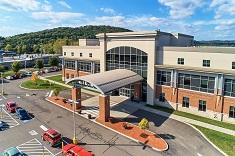
Platelet Rich Plasma (PRP) Injection
What is a Platelet Rich Plasma (PRP) injection?
Platelet Rich Plasma (PRP) injection is a procedure we offer in the Binghamton area that uses growth factors found in your own blood to stimulate and improve healing at sites of injury.
Platelets contain many chemical signal molecules that cause cells to divide, produce protein, and generate a healing response. Whenever you have a cut, platelets aggregate to form the clot, then release these chemical signals to induce healing. By concentrating platelets from your blood and injecting them into an injured joint, tendon, or ligament, we can stimulate more rapid healing
in the area.
What happens in the procedure?
Your blood is drawn, usually from the elbow, and spun in a centrifuge for several minutes. The spinning causes the blood to separate into layers and the layer with the platelets and growth factors is isolated and injected into the treatment area. In order to improve the accuracy of placement, the injection is frequently done with ultrasound guidance. Once injected into the site, the growth factors accelerate healing.
How long does the procedure take?
The actual PRP injection may take from a few seconds to a few minutes depending on the specific site, but you should expect your appointment to take 30-60 minutes. Some research suggests that for certain complaints a series of 3 injections over several weeks may be superior to a single isolated injection.
How safe is PRP?
PRP injections offered at our Binghamton area clinic are extremely safe. PRP is a component of your own blood, therefore you cannot be allergic to it and this eliminates medication side-effects. Occasionally a local numbing medicine is used with some injections, but this is generally very safe as well. As with any injection, there is a small risk of infection, bruising, or injury to nearby structures.
Who can have PRP?
Almost anyone can have PRP. Your doctor may recommend avoiding PRP injections if you have:
- A history of metastatic cancer
- An infection near the treatment site or severe infection elsewhere
- A blood-clotting disorder
- Severe liver disease
Will PRP interact with my medications?
No, PRP does not interact with any medications, but some medications or substances may reduce the effectiveness of PRP. Your physician will advise you of any medications that should be avoided around the time of your injection. Smoking reduces the effectiveness of PRP.
If I get PRP what can I take for pain?
Usually the pain after a PRP procedure is minor. You may take acetaminophen (Tylenol) if desired. Icing is generally discouraged since it will reduce blood flow to the area.
What conditions are treated by PRP injection?
PRP has been used for many conditions, both related to the musculoskeletal system and to other systems. At UHS Sports Medicine in the Binghamton region, we primarily use PRP to treat:
- Arthritis
- Injuries of tendons
- Injuries of ligaments
- Muscle tears
PRP is also used during select surgeries to promote healing.
Interested in PRP?
Please call the UHS Orthopedic Center at 607-771-2220 to schedule an appointment for plasma treatment in the Binghamton area.
UHS News
-
 UHS unveils expanded Upper Front Street locationDecember 15, 2025
UHS unveils expanded Upper Front Street locationDecember 15, 2025On the morning of Monday, December 15, UHS held a ribbon cutting to mark the opening of the expanded UHS Upper Front Street location. The event saw a great turnout, celebrating an exciting new chapter for care in our community.
-
 New CT scanner at UHS Chenango Memorial Hospital offers advanced diagnosticsDecember 15, 2025
New CT scanner at UHS Chenango Memorial Hospital offers advanced diagnosticsDecember 15, 2025UHS Chenango Memorial Hospital’s Diagnostic Imaging team recently celebrated the installation of a state-of-the-art CT scanning machine, marking a significant advancement in diagnostic capabilities for patients in the region.
-
 Inside look at expanded UHS Upper Front Street locationDecember 11, 2025
Inside look at expanded UHS Upper Front Street locationDecember 11, 2025Monday marks the opening of Primary Care, Physical Therapy & Rehabilitation, and Laboratory services at the renovated location, with the new Pediatrics space scheduled to open in February.
-
 2026 Summer Nurse Externship application window now openDecember 08, 2025
2026 Summer Nurse Externship application window now openDecember 08, 2025UHS is thrilled to re-offer our Summer Nursing Externship Program in 2026. This is an exclusive opportunity for current nursing students to jump into the world of healthcare and gain hands-on experience.



